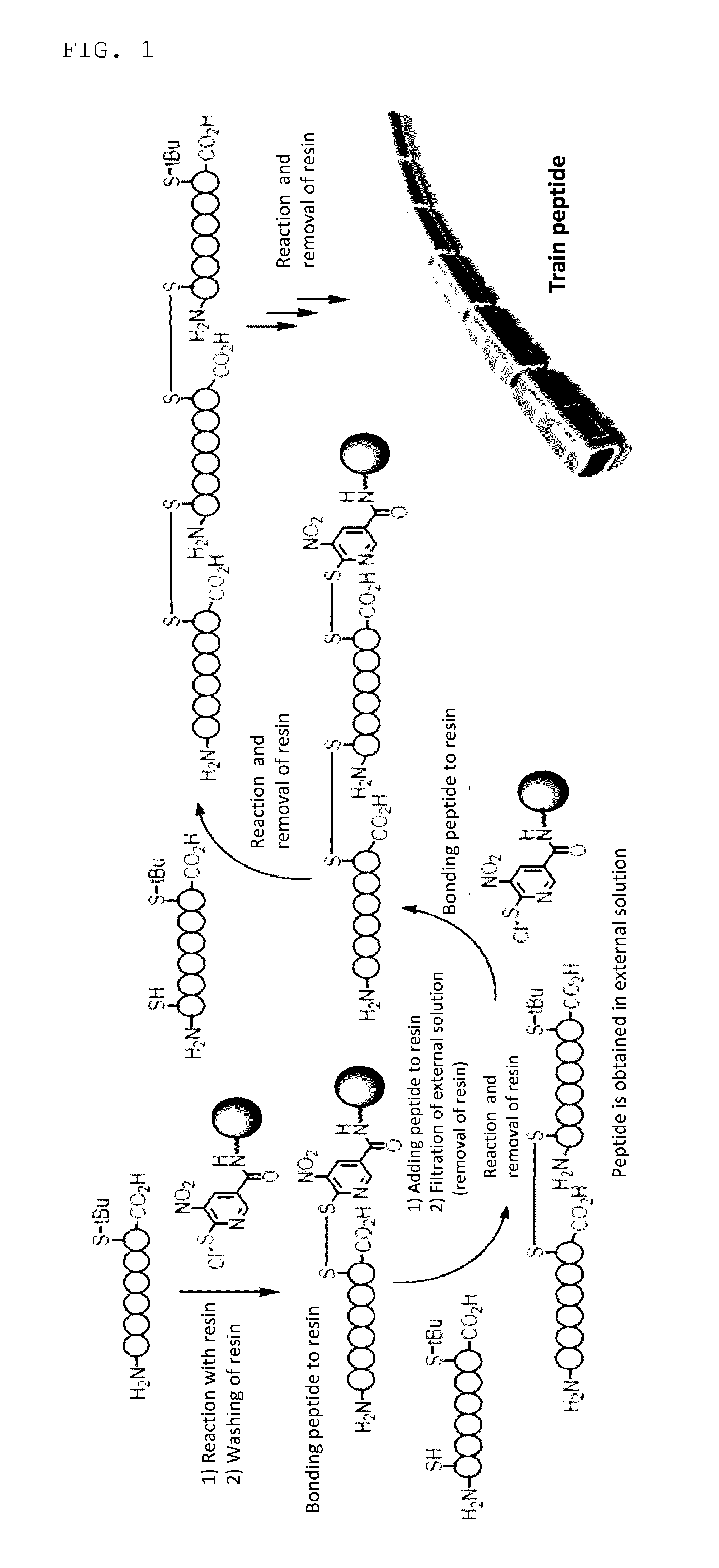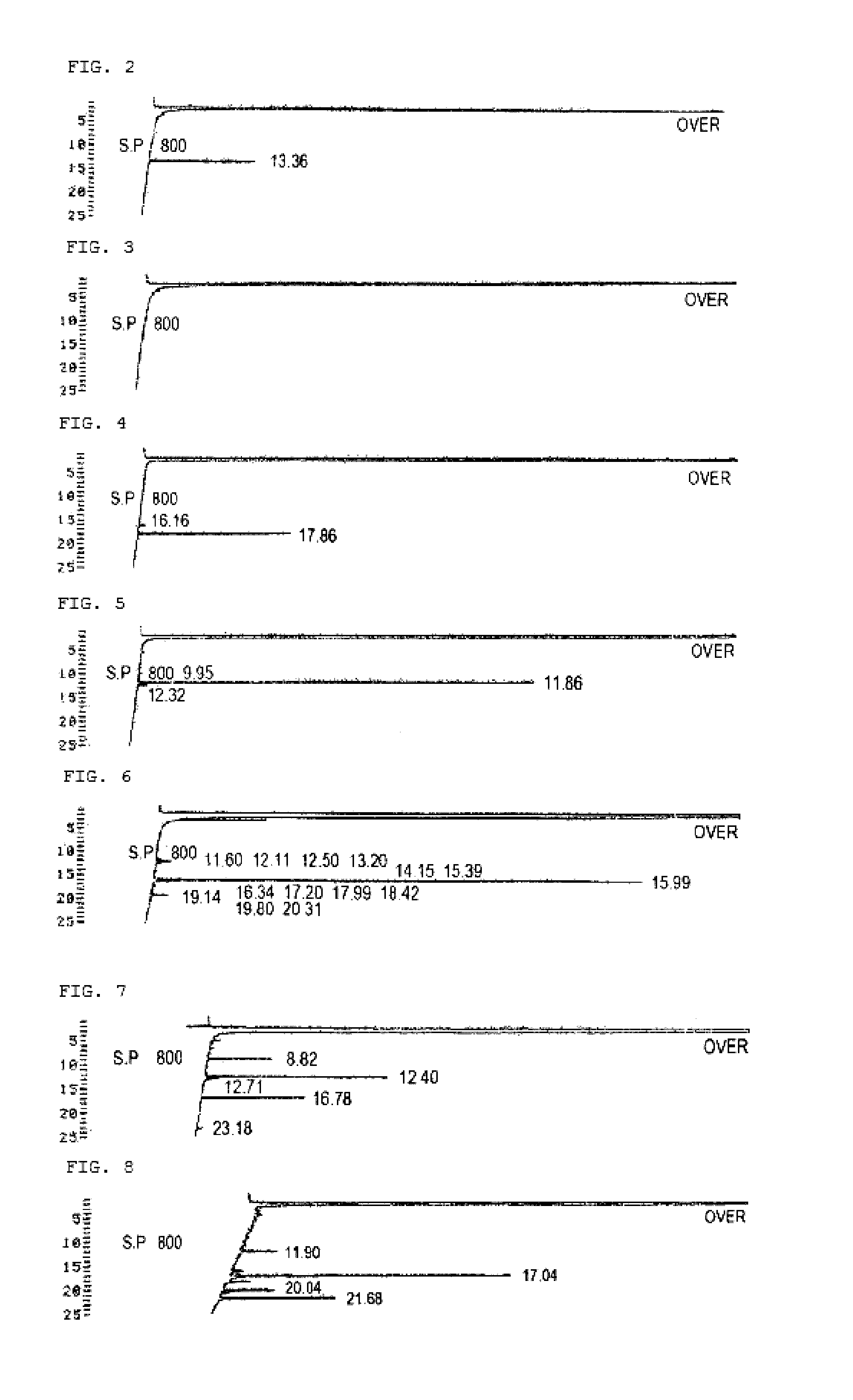Novel compound, production method therefor, and application therefor
a production method and compound technology, applied in the field of new compound, can solve the problems of inability to apply techniques, damage to the accuracy of site identification and activity measurement, and the original purpose of the measurement,
- Summary
- Abstract
- Description
- Claims
- Application Information
AI Technical Summary
Benefits of technology
Problems solved by technology
Method used
Image
Examples
example 1
[0187]The synthesis of compound A is shown below as an example of a compound of the present invention.
Synthesis of compound A (6-chlorosulfenyl-5-nitronicotinemethylamide resin)
[0188]Compound A was synthesized according to the following scheme.
[0189]Resin: Crosslinked Polyethylene Glycol (Methyl ChemMatrix® Resin)
[0190](1) Synthesis of Compound 2
[0191]Compound 1 (25 g, 0.180 mol) was placed in a 500 mL recovery flask, and fuming nitric acid (1.52) (125 mL) was added. The flask was gradually heated using an oil bath while stirring, and stirring was conducted for 5 hours at 50° C. After stopping heating and allowing to cool to room temperature, the reaction solution was concentrated under reduced pressure. The residue obtained was cooled by an ice bath, and recrystallized using methanol as the solvent. Compound 2 (9.77 g, 0.053 mol) was obtained by drying the solid obtained by filtration, under reduced pressure.
[0192]1H NMR (300 MHz, CD3OD) 8.44 (d, J=2.6 Hz, 1H), 8.85 (d, J=2.6 Hz, 1...
example 2
[0206]The synthesis of compound B is shown below as an example of a compound of the present invention.
Synthesis of compound B (5-((6-(methylamino resin)-6-oxohexyl)amino)-6-oxohexyl)carbonyl)-3-nitropyridine-2-sulphenyl chloride)
[0207]Compound B was synthesized according to the following scheme.
[0208]Resin: Crosslinked Polyethylene Glycol (Methyl ChemMatrix® Resin)
[0209](1) Synthesis of Compound 8
[0210]9-Fluorenylmethyloxycarbonylaminocaproic acid (compound 7, 632.4 mg, 1.79 mmol), (O-(7-azabenzotriazol-1-yl)-N,N,N′,N′-tetramethyluronium hexafluorophosphate) (540.6 mg, 1.76 mmol), DMF (16 mL), and diisopropylethylamine (257.0 μL, 1.79 mmol) were added sequentially to a 15 mL polypropylene tube and shaken and stirred for one minute. A quantity of 511.7 mg of aminomethyl ChemMatrix resin (in the formula, H2N-Resin, functional group substitution rate 0.70 mmol / g) was placed in a separate 60 mL polypropylene tube equipped with a filtration frit, and the solution in the 15 mL tube was ad...
example 3
[0221]Octaarginine derivative modification of captopril (compound 13), a compound having an SH group, was carried out in accordance with the following synthesis scheme using compound A.
[0222]Resin: Crosslinked Polyethylene Glycol (Methyl ChemMatrix® Resin)
[0223]90% Formic acid aqueous solution (2 mL) was added to a 10 mL glass test tube containing compound A and a stirring bar while cooling by ice bath, and solvent substitution was carried out by stirring gently. After removing the wash solution by a Pasteur pipette, 90% formic acid aqueous solution was again added, and washing was repeated in the same way 5 times. An octaarginine-containing peptide Ac-Arg8-Acp-Cys(tBu)-NH2.TFA salt (143.37 mg) comprising 10 residues was dissolved in 90% formic acid (1 mL) in a separate 30 mL Erlenmeyer flask, and the aqueous solution obtained was added to the above 10 mL glass test tube containing compound A while cooling by ice. After stirring gently for 2 hours while cooling by ice, the solution ...
PUM
| Property | Measurement | Unit |
|---|---|---|
| temperature | aaaaa | aaaaa |
| temperature | aaaaa | aaaaa |
| temperature | aaaaa | aaaaa |
Abstract
Description
Claims
Application Information
 Login to View More
Login to View More - R&D
- Intellectual Property
- Life Sciences
- Materials
- Tech Scout
- Unparalleled Data Quality
- Higher Quality Content
- 60% Fewer Hallucinations
Browse by: Latest US Patents, China's latest patents, Technical Efficacy Thesaurus, Application Domain, Technology Topic, Popular Technical Reports.
© 2025 PatSnap. All rights reserved.Legal|Privacy policy|Modern Slavery Act Transparency Statement|Sitemap|About US| Contact US: help@patsnap.com



